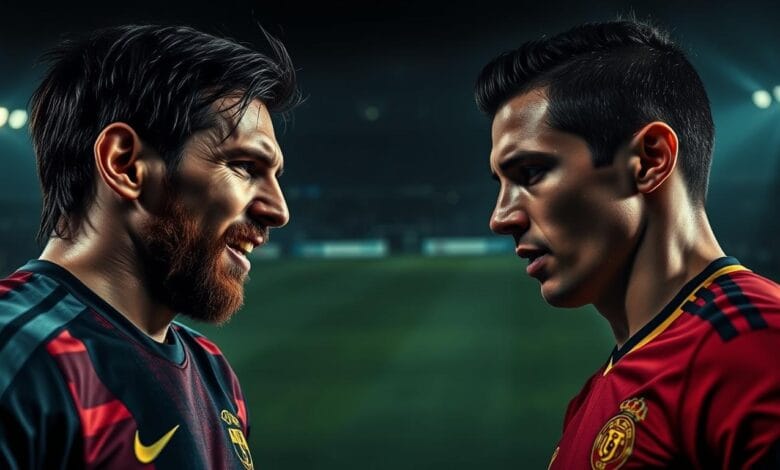
Watching your favorite soccer stars, you might wonder how they keep up even as they get older. For Lionel Messi and Cristiano Ronaldo, it’s not just about being strong. It’s also about staying mentally tough.
After turning 35, these athletes face big challenges. The constant pressure and physical strain can cause burnout. But how do they deal with these issues?
Learning about elite athlete burnout can help us understand the struggles of professional athletes. Messi and Ronaldo’s careers after 35 are a great example to study.
Key Takeaways
- The pressures of being a professional soccer player can lead to mental and physical exhaustion.
- Messi and Ronaldo’s careers beyond 35 offer insights into managing athlete burnout.
- The impact of aging on performance is a critical factor in elite athlete burnout.
- Understanding burnout can help athletes and coaches develop strategies for maintaining peak performance.
- The comparison between Messi and Ronaldo highlights different approaches to managing the challenges of aging in professional sports.
The Phenomenon of Elite Athlete Burnout
Elite athletes face unique challenges that can lead to burnout. This is a growing issue in professional sports. It’s key to understand what causes this condition.
Defining Burnout in Professional Sports
Burnout in sports is a state of exhaustion from stress, overtraining, and pressure. Athletes feeling detached, exhausted, and unmotivated are common signs. It affects their job satisfaction and performance.
Studies show burnout is a big worry for football players. It impacts their well-being and career length.
Why Age 35 Is a Critical Milestone
Age 35 is a key time for athletes due to natural aging. They may see decreased stamina, reduced flexibility, and longer recovery times. This makes it hard to keep up their performance.
The years of intense training and competition take a toll. It increases the risk of burnout.
Career Trajectories: Messi and Ronaldo Before 35
Looking at Messi and Ronaldo’s early careers helps us understand their later years. Both were stars before they turned 35. Their paths to fame were remarkable.
Messi’s Rise and Peak Years
Lionel Messi became famous early at FC Barcelona. By his early 20s, he was a top player. His peak, from 2008 to 2012, brought him many awards, including Ballon d’Or titles.
Messi’s skills in dribbling and scoring made him a standout for over a decade.
Ronaldo’s Development and Prime
Cristiano Ronaldo’s career path was different. He grew up at Sporting CP and Manchester United. His best years were from 2008 to 2014, winning titles with Manchester United and Real Madrid.
| Player | Peak Years | Notable Achievements |
|---|---|---|
| Messi | 2008-2012 | Multiple Ballon d’Or titles, record-breaking goal scorer |
| Ronaldo | 2008-2014 | Champions League titles, multiple league championships |
Messi and Ronaldo’s early careers were filled with success. Their achievements before 35 set the stage for their later years. Now, they face the challenge of burnout after 35.
Physical Demands on Aging Elite Athletes
Aging elite athletes face many physical challenges that can shorten their careers. As they hit their mid-to-late 30s, their bodies change naturally. These changes can affect their performance on the field.
Decline in Physical Abilities
After 35, elite athletes see a drop in their physical skills. This can show up as slower speed, less flexibility, and lower endurance. For example, muscle loss speeds up after 35, affecting overall performance.
Recovery Challenges for Veterans
Recovery gets tougher for veteran athletes. The body takes longer to heal from hard workouts as it ages. This makes it harder to recover from injuries or tough games.
This can start a cycle where poor performance leads to more fatigue. This further worsens the decline in sports performance.
| Physical Attribute | Change After 35 | Impact on Performance |
|---|---|---|
| Speed | Decreases | Reduced ability to keep up with younger players |
| Flexibility | Reduces | Increased risk of muscle injuries |
| Endurance | Lowers | Decreased stamina over the course of a match |
It’s key to understand these physical demands and their effects on aging athletes. By recognizing the natural decline in abilities and tackling recovery issues, athletes and their teams can lessen the impact of aging on sports performance.
Elite Athlete Burnout: Messi Ronaldo Age Comparison
As elite athletes get older, the risk of burnout grows. This is especially true for stars like Messi and Ronaldo. Their careers after 35 show the physical and mental hurdles aging athletes face.
Signs of Burnout in Messi’s Performance
Lionel Messi, famous for his speed and scoring, shows burnout signs. His speed and stamina on the field have dropped. Coaches now play him more strategically, to save his energy. His stats show a drop in goals and activity.
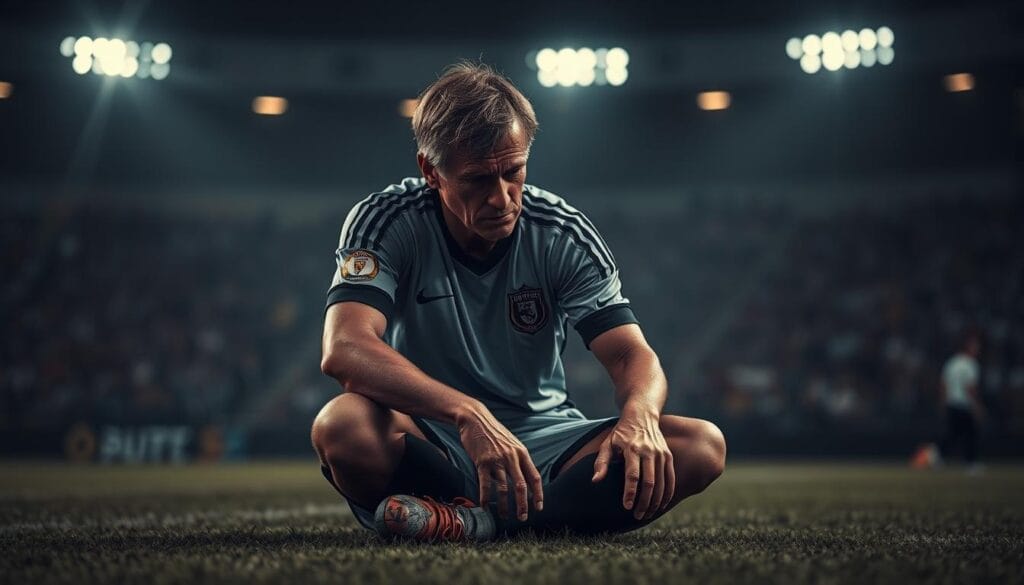
Indicators of Fatigue in Ronaldo’s Game
Cristiano Ronaldo stays fit well into his 30s. But, signs of fatigue appear in his game. His speed and recovery time between matches have increased. His training is now more intense to fight aging. Yet, he sometimes loses focus during games.
| Performance Indicator | Messi | Ronaldo |
|---|---|---|
| Goal-scoring rate | Gradual decline | Consistent, with slight decrease |
| Endurance | Noticeable decrease | Slight decrease |
| Training Regimen | Strategic management | Intense, focused on recovery |
Messi and Ronaldo’s stories show the tough balance between aging, mental fatigue, and sports pressure. As athletes age, fighting burnout is key to extending their careers.
Psychological Resilience: Mental Fortitude After 35
Mental toughness is key for top athletes, helping them deal with sports pressure as they get older. Stars like Messi and Ronaldo have kept up their game well into their 30s. Their mental strength is a big part of this.
Messi’s Mental Approach to Aging
Lionel Messi stays calm and focused as he ages. His ability to stay cool under pressure has marked his career. He understands the game deeply, making smart choices that save energy but keep him effective.
Messi’s psychological resilience shows in his ability to adapt. He’s changed his game, moving from a fast winger to a strategic playmaker. This change shows his mental flexibility and openness to new approaches.
Ronaldo’s Psychological Adaptations
Cristiano Ronaldo is known for his hard work and keeping fit. His mental game is about never giving up and always striving for the best. Ronaldo’s psychological adaptations include intense training and recovery, keeping him at the top.
Ronaldo also handles pressure and criticism well. He has strong self-confidence, which helps him perform even when everyone is watching.
| Mental Strategy | Messi | Ronaldo |
|---|---|---|
| Adaptability | Adjusted playing style to conserve energy | Maintains intense work ethic |
| Pressure Handling | Remains composed under pressure | Developed strong self-belief |
| Training Regimen | Focus on tactical decisions | Rigorous training and recovery |
Statistical Performance Analysis Post-35
As elite athletes age, their performance statistics often change a lot. It’s key to look at Messi and Ronaldo’s careers after 35. This will show how they’ve adapted to the game’s physical and mental demands with age.
Messi’s Numbers: Before and After 35
Messi’s career is known for its incredible consistency. Yet, like all athletes, he has seen changes in his performance over time. Before 35, Messi was famous for his goal-scoring and creativity.
Goal Production Decline or Evolution?
After 35, Messi’s goal production has changed. The numbers have gone down a bit, but he still creates chances for his teammates. This change in his game is seen in the stats.
| Season | Goals Scored | Assists |
|---|---|---|
| Before 35 | 35.2 per season | 12.5 per season |
| After 35 | 28.5 per season | 11.8 per season |
Assist and Creation Metrics
Messi’s assist numbers are still impressive after 35. This shows he can still create chances. The slight drop in goals is balanced by his vision and passing.
Ronaldo’s Statistics: The Age Effect
Ronaldo, known for his athleticism and fitness, has seen changes in his stats after 35. His career path is interesting compared to Messi’s.
Scoring Efficiency Changes
Ronaldo’s scoring efficiency has dropped after 35, but he’s still a top goal-scorer. The data shows a shift in his role and reliance on teammates for goals.
Physical Performance Indicators
Ronaldo’s sprint speed and endurance have decreased after 35. But, he’s adapted through tactical changes, keeping his effectiveness on the field.
Tactical Adaptations to Combat Burnout
Messi and Ronaldo have made big changes to fight burnout. As they got older, they changed how they play to stay good on the field.
How Messi Modified His Playing Style
Lionel Messi has changed his game to save energy but still be key. He now focuses on making smart passes instead of always trying to beat defenders. This helps him stay creative without getting too tired.
Ronaldo’s Evolution to Preserve Effectiveness
Cristiano Ronaldo has also changed his game. He works hard to keep his fitness up, so he can still play at top level. He also picks his shots better, choosing easier chances and helping his teammates score.
| Adaptation | Messi | Ronaldo |
|---|---|---|
| Dribbling | Reduced frequency | Maintained skill |
| Playmaking | Increased strategic passing | Focused on high-intensity moments |
| Physical Conditioning | Conserves energy | Maintains elite fitness |
These changes have helped Messi and Ronaldo keep playing well. They’ve managed to stay in the game longer, fighting off burnout.
Career Management Decisions
Aging elite athletes face big decisions that shape their careers, like Messi and Ronaldo’s recent choices. These choices are influenced by professional sports burnout, personal goals, and money.

Messi’s Move to Inter Miami: Burnout Factor?
Lionel Messi’s choice to join Inter Miami CF has brought up the topic of burnout. His move might be a smart way to refresh his career. But it also makes people wonder about the toll of constant pressure to perform on athletes.
- Desire for new challenges
- Personal fulfillment outside of European football
- Potential reduction in competitive pressure
Ronaldo’s Saudi Arabia Choice: Escaping Pressure?
Cristiano Ronaldo’s move to Al Nassr in Saudi Arabia is seen as a break from European football’s intense watch. This choice shows the tough choices high-profile athletes make to balance their careers and personal lives.
“The move to Saudi Arabia is a strategic one, allowing me to stay competitive while also exploring new opportunities,” Ronaldo stated, reflecting on his career management decisions.
Media Scrutiny and Its Impact on Burnout
The intense media scrutiny on elite athletes can deeply affect their mental health. Athletes like Messi and Ronaldo face not just physical challenges but also the mental strain of constant observation.
Public Expectations and Criticism
Public expectations can be a big stress for aging athletes. The constant criticism from media can lower their confidence and lead to athlete mental health issues. It’s hard to imagine how these athletes deal with the pressure.
Social Media Pressure on Aging Stars
Social media makes things even harder, as athletes see fans’ opinions, both good and bad. For high-profile athletes, handling this is key to keeping their mental health. The need to perform and the constant watch can make burnout worse.
It’s important to understand how media scrutiny affects athlete mental health. This knowledge helps support these athletes throughout their careers and beyond.
The Role of Team Environment in Preventing Athlete Fatigue
Preventing athlete fatigue is not just about individual effort. It also needs a supportive team environment. As athletes get older, their recovery and performance are greatly influenced by the support around them.
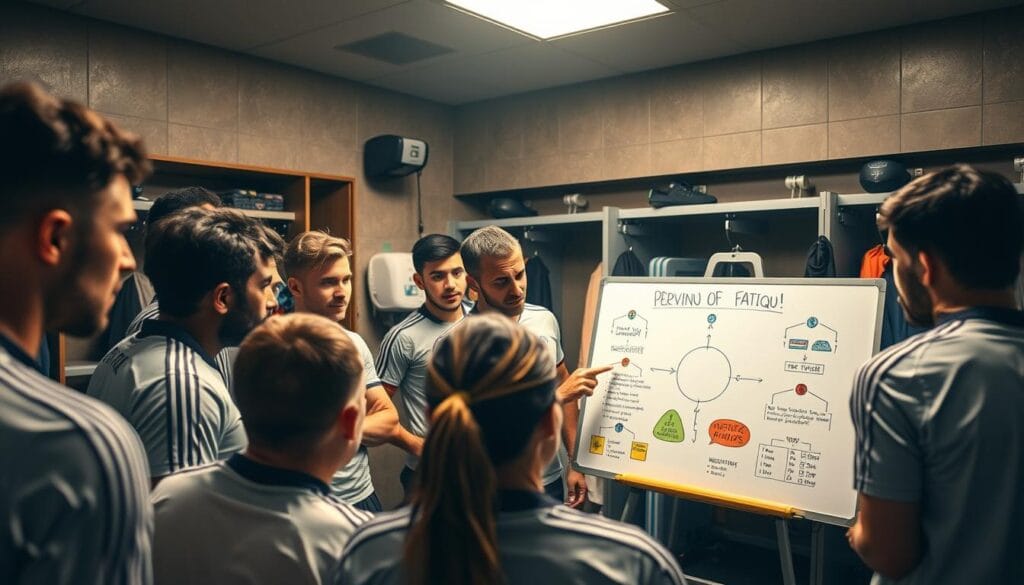
Support Systems for Aging Superstars
Athletes like Messi and Ronaldo get a lot of help from their teams. They have personalized coaching, advanced sports science, and mental performance coaching. Experienced athletic trainers and physical therapists help manage the physical effects of aging.
A supportive team culture is also key. It understands and meets the needs of veteran players. This includes flexible training and recovery plans tailored to each player.
How Teams Accommodate Veteran Needs
Teams can help veteran players by adjusting their roles and reducing physical demands. For example, a veteran might focus on strategy rather than physical performance. This helps them stay involved without burning out.
| Accommodation Strategy | Description | Benefit |
|---|---|---|
| Flexible Training | Adjusting training intensity and frequency based on the athlete’s condition. | Reduces risk of injury and burnout. |
| Role Adjustment | Modifying the player’s role to leverage their strengths and experience. | Maintains team performance while preserving the athlete’s energy. |
| Enhanced Recovery Protocols | Providing additional recovery resources such as physiotherapy and mental coaching. | Improves overall well-being and performance longevity. |
By using these strategies, teams can help prevent athlete fatigue. This way, they can extend the careers of their veteran players.
Family Life and Work-Life Balance
Keeping a balance between work and family is key for athletes’ mental health, especially after 35. Stars like Messi and Ronaldo face aging challenges. Their family life greatly influences their career choices.
Messi’s Family Influence
Messi’s family is a big part of his career. His wife, Antonella, and kids offer emotional support, helping him concentrate on his job. Family stability is vital for handling the stress of fame.
Ronaldo’s Personal Life
Ronaldo thanks his family for his long career. His partner, Georgina Rodríguez, and kids motivate him.
“Family is everything to me,” Ronaldo has said, showing how important his personal life is to his professional drive.
| Athlete | Family Influence | Career Impact |
|---|---|---|
| Messi | Strong family support | Enhanced mental well-being |
| Ronaldo | Family as motivation | Increased professional drive |
Financial Considerations and Professional Sports Burnout
The money side of sports careers can be both good and bad. It offers security but can also lead to burnout. Stars like Messi and Ronaldo face big decisions as they get older, with money playing a big part.
Economic Security vs. Competitive Drive
Top athletes are driven to win, but they also need to make money. The need to perform well is huge, especially with big contracts and endorsements. A study showed that athletes with more money often feel more stress, which can cause burnout.
| Financial Factor | Impact on Athletes | Potential for Burnout |
|---|---|---|
| Lucrative Contracts | High Expectations | Increased |
| Endorsement Deals | Pressure to Perform | Moderate |
| Economic Security | Reduced Stress | Decreased |
Endorsement Pressures on High-Profile Athletes
Stars under pressure from endorsements can suffer mentally and physically. The constant watch and need to perform can cause burnout. Athletes must find a balance between their drive to win and the money from endorsements.
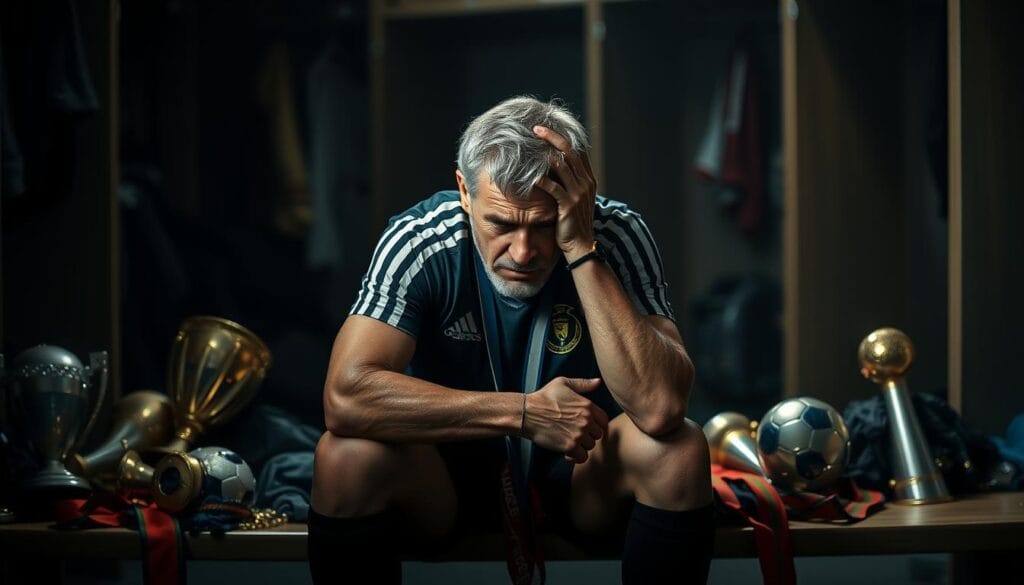
Medical and Recovery Innovations
Medical tech and recovery methods are key for top athletes to keep playing. As athletes get older, their bodies change, making recovery harder. Stars like Messi and Ronaldo use new ways to stay in top shape.
Messi’s Reported Recovery Regimen
Lionel Messi’s recovery plan covers diet and rest. It’s all about keeping his body strong and ready for action.
Nutrition and Sleep Protocols
Messi sticks to a special diet to help his body recover. He also makes sure to get enough sleep. This helps his body fix and refresh itself.
Injury Prevention Strategies
Messi also works on avoiding injuries. He does exercises to build muscle and improve flexibility. This keeps him safe from getting hurt.
Ronaldo’s Famous Fitness Approach
Cristiano Ronaldo is known for his tough fitness routine. It includes advanced training and recovery methods. His plan is strict and keeps him in top shape.
Training Modifications with Age
Ronaldo has changed his training as he’s gotten older. Now, he focuses more on recovery and less on intense workouts. This helps him stay strong and avoid getting tired.
Recovery Technologies Utilized
Ronaldo uses new tech like cryotherapy and advanced physiotherapy. These help his body recover from sports stress. This way, he can keep his performance high.
Legacy Concerns and Their Psychological Impact
As stars like Messi and Ronaldo near the end of their careers, legacy worries weigh heavily on their mental health. The need to be seen as among the greatest athletes of all time is huge. It can mess with their game and their happiness.
The constant watch and comparison to other legends is hard on athletes’ mental strength. It’s interesting to think about how they handle the stress of fame and the wish to leave a mark.
The GOAT Debate Pressure
The question of who is the Greatest of All Time (GOAT) is a big stress for athletes like Messi and Ronaldo. Being seen as one of the best is both a blessing and a curse. It adds more pressure and attention to their games.
Playing for History vs. Present Success
Athletes often struggle with whether to focus on winning now or building a legacy. This inner battle can mess with their choices and mood. Here’s a look at the differences between playing for history and winning now:
| Aspect | Playing for History | Present Success |
|---|---|---|
| Motivation | Legacy and long-term recognition | Immediate results and current season performance |
| Pressure | High, due to the desire to be remembered | Moderate, focused on current goals |
| Decision Making | Influenced by long-term implications | Driven by short-term needs |
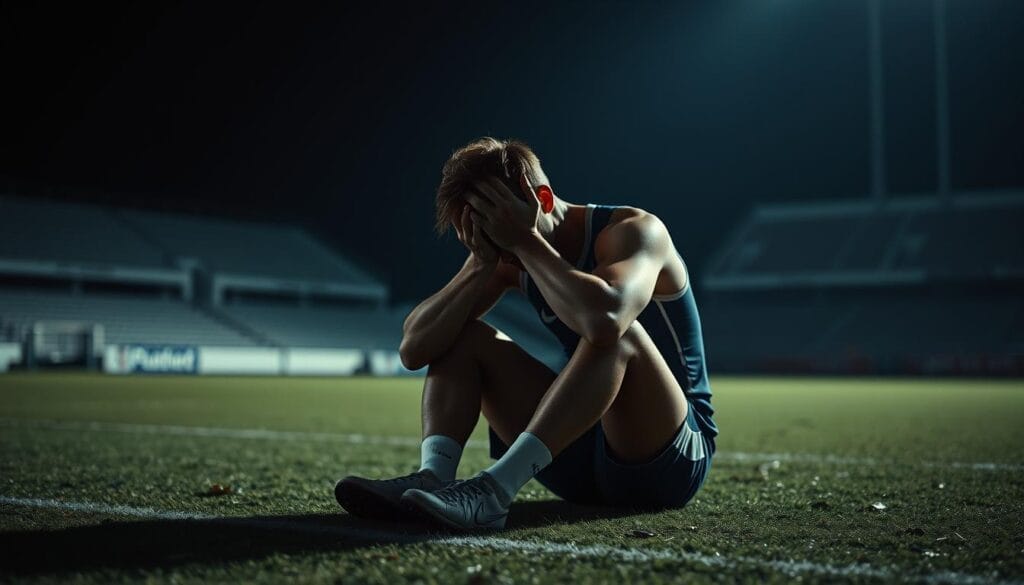
The mental toll of legacy worries on elite athletes is complex. It’s shaped by the GOAT debate and the balance between playing for history and winning now. Understanding these factors helps us see the mental health challenges faced by famous athletes.
Preventing Athlete Fatigue: Lessons for Future Stars
The issue of elite athlete burnout shows we need to act early to keep athletes playing long. Looking at stars like Messi and Ronaldo, we see how key it is to stop athlete fatigue. This is vital for lasting success in sports.
Career Longevity Planning
Planning for a long career in sports is about more than just playing. It’s about staying healthy physically and mentally, and making smart plans. Athletes need to focus on recovery, like good food and therapy, to keep their bodies strong. They also need to change their training as they get older.
| Strategy | Description | Benefits |
|---|---|---|
| Advanced Nutrition | Personalized dietary plans | Enhanced recovery, improved performance |
| Physical Therapy | Regular maintenance and injury prevention | Reduced risk of injury, improved flexibility |
| Adapted Training | Modified exercises to suit aging athletes | Maintained performance, reduced fatigue |
Burnout Prevention Strategies
To avoid burnout, we need to help athletes in many ways. They should learn to manage stress, like through meditation. Also, having a strong support team, like family and coaches, helps a lot.
Conclusion
Looking at Messi and Ronaldo’s careers shows how hard it is to stay at the top after 35. Their stories give us key lessons on avoiding burnout and staying fresh. This is crucial for athletes aiming to keep performing well.
Messi and Ronaldo have shown us how to adapt and make smart choices as they age. They’ve changed their game and made big decisions to keep up with the demands of their sport. This shows the challenges of aging in sports.
It’s important to understand what causes burnout in athletes. Things like media pressure, team dynamics, and money matters play a big role. By learning from Messi and Ronaldo, we can see how managing a career, staying mentally strong, and having support are key to success.
The sports world is always changing, and Messi and Ronaldo’s experiences can guide us. By focusing on athlete well-being and creating personalized plans, we can help athletes stay healthy and perform their best. This way, they can enjoy long, successful careers.
FAQ
What is elite athlete burnout?
Elite athlete burnout is when top athletes feel exhausted. This happens due to too much stress, pressure to win, and hard training.
Why is age 35 a critical milestone for athletes?
At 35, athletes start to lose their physical strength. They’ve also been under a lot of stress for years. This makes burnout more likely.
How do Messi and Ronaldo’s career trajectories compare before age 35?
Messi and Ronaldo became famous in their early 20s. Messi won his first Ballon d’Or at 22, Ronaldo at 23. They kept playing at a high level well into their 30s.
What are the signs of burnout in Messi’s performance after 35?
After 35, Messi’s goal-scoring and speed have dropped. But he’s found ways to keep playing well.
How has Ronaldo’s psychological approach contributed to his continued performance after 35?
Ronaldo’s hard work, fitness, and mental strength help him stay at the top. Even as he gets older.
What role do media scrutiny and public expectations play in burnout?
The media and fans can make athletes feel burned out. They face too much pressure, criticism, and stress.
How can teams help prevent burnout in aging athletes?
Teams can offer support like sports psychologists and flexible training. This helps veteran players stay healthy.
What is the impact of financial considerations on professional sports burnout?
Money can cause burnout. Athletes might feel forced to keep playing, even when tired. They want to keep their endorsements and secure their future.
What lessons can be learned from Messi and Ronaldo’s approaches to preventing athlete fatigue?
Messi and Ronaldo’s career management shows how to avoid burnout. Their training, recovery, and mental prep are key.
How do legacy concerns affect elite athletes like Messi and Ronaldo?
The desire to be the best can be overwhelming. It adds pressure and can lead to burnout.
What strategies can be employed to prevent burnout in professional athletes?
To avoid burnout, athletes need a plan for their career. They should have personalized training, mental health support, and a supportive team. This helps them balance work and life.




